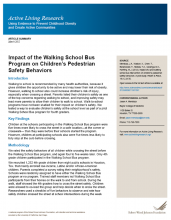We are pleased to announce an exciting new alliance between Active Living Research and GP RED to co-host and coordinate...
Impact of the Walking School Bus Program on Children’s Pedestrian Safety Behaviors
The Challenge: Walking to school is recommended by many health authorities, because it gives children the opportunity to be active and may lower their risk of obesity. However, walking to school also could increase children’s risk of injury, especially when crossing a street.
Make an impact: Improving the safety of walking to school programs may lead more parents to allow their children to walk to school.
What the findings are about: This study tested a way to evaluate children’s safety at the school level as part of a pilot Walking School Bus program for fourth graders.
- Children at the schools participating in the Walking School Bus program were five times more likely to cross the street in a safe location—at the corner or crosswalk— than they were before their schools started the program.
- Children's safety behaviors were more strongly related to whether their school participated in the Walking School Bus than to the number of traffic lanes or parents’ perceptions of neighborhood safety.
- Traffic lanes and perceived neighborhood safety may have less of an effect on children’s behavior than the influence of peers, adults or crossing guards.
- Because walking to school may increase children’s risk of pedestrian injury, walk-to-school programs, such as the Walking School Bus, should be designed to make this activity as safe as possible.
Read the full article: Impact of a Pilot Walking School Bus Intervention on Children’s Pedestrian Safety Behaviors: A Pilot Study
- DOWNLOAD "Impact of the Walking School Bus Program on Children’s Pedestrian Safety Behaviors" PDF (0.03 MB) Article Summary
Related Tools & Resources
STAY UP TO DATE
RECENTLY ADDED TOOLS & RESOURCES
MOVE! A BLOG ABOUT ACTIVE LIVING
The "Active Living Conference" aims to break down research and practice silos and...








